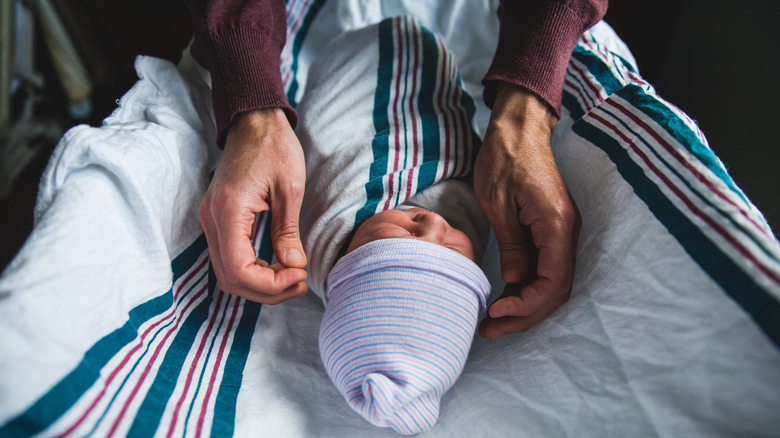
You don’t need to have had a baby to recognize the baby blanket most infants are wrapped in after birth. Made of flannel and featuring pink and blue stripes, these blankets have been used in hospitals since their creation in the 1950s. While they are cozy and adorable, have you ever wondered why every hospital uses them? Is there a reason for this specific choice of receiving blanket? Short answer: yes.
“They’re very absorbent when you first get them. They wash well,” said Nurse Donna Clark, manager of the maternity ward at Advocate Condell Medical Center in Libertyville, Illinois, to NPR. “They’re the right size for the baby. They’re gender neutral, so we don’t get a dad saying, ‘You’re putting my boy in pink or my girl in blue!'” With a wholesale price of $2.50 per blanket, they’re also cost-effective for hospitals to purchase in bulk.
These blankets have also become an essential part of our collective experience. Since they’ve been used in so many hospitals for over half a century, the blanket is now synonymous with newborns, providing a certain familiarity that comforts not just new parents, but our culture as a whole.
Who makes hospital baby blankets

Interestingly, this blanket has a name: Candy Stripe. The name is fitting based on its color and design. Candy Stripe is part of the Kuddle-Up Flannel Baby Blankets line by Medline. “It was just one of those things that they … (wanted to) make sure that it’s very simple and gender neutral, and a stripe was the easiest, most simple way to do that,” explained Teri Burke, director of patient apparel at Medline Industries, to ABC 15 Arizona. While other designs include dinosaurs, ducks, baby chicks, and some solid options, Candy Stripe remains the most popular, with 1.5 million sold each year.
Created by the Chicago-based company A.L. Mills, baby blankets weren’t their first design; initially, they made smocks for butchers in the early 1900s. When the company shifted focus to hospital products, their first invention was a surgical uniform made in green fabric, chosen for its calming effect and its contrast to red, reducing eye strain during surgery (according to Medicus). By the 1950s, A.L. Mills began making baby blankets, leading to significant success. Today, known as Medline, the company is a billion-dollar enterprise specializing in medical supplies, and the initial blanket design remains unchanged.
Why you’re not supposed to bring the blanket home

While it’s hard not to adore the Candy Stripe blanket and how your infant looks in it, it is intended to stay in the hospital. It’s called a receiving blanket for a reason. The rationale includes hygiene – your infant should have their own new and clean blankets at home – and the fact that receiving blankets are not designed for long-term use, lasting about 15 washings and dryings before needing replacement. In hospitals, many blankets appear faded due to frequent washing after each use.
Despite this guideline, many parents over the years have taken the receiving blanket home for sentimental reasons or as a keepsake. Sometimes, blankets go missing because new parents are frazzled as they attempt to get their infant out the door and into a car seat. Whether you accidentally or intentionally bring one of these blankets home, don’t worry. Hospital staff are more concerned about your baby’s well-being than whether or not parents take a blanket.

